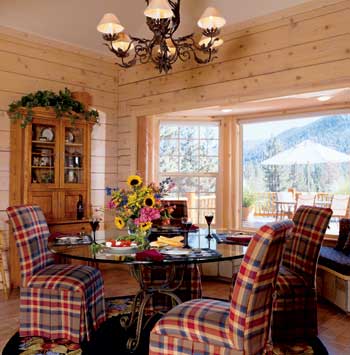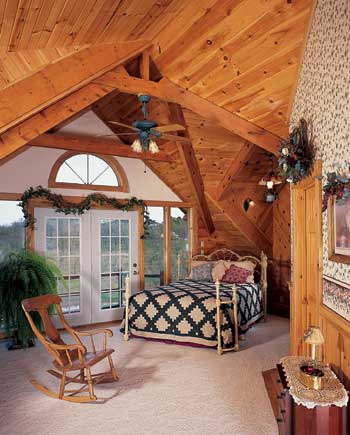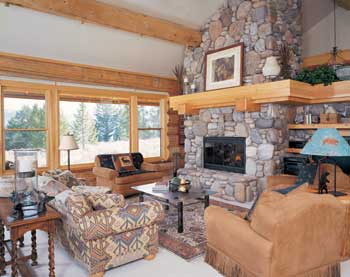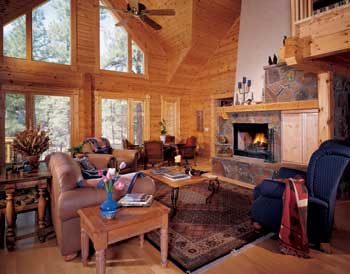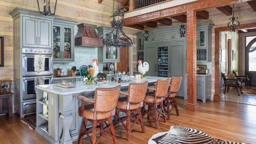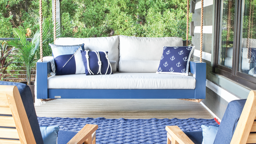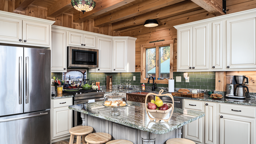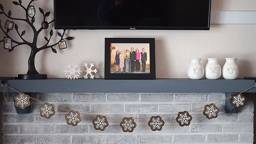The anticipation is over, and you've finally moved into your dream home. Unpacked boxes sit at the ready and your old furniture, which doesn't seem to work as well in the new space, is strewn pell-mell throughout the rooms. You thought the loading and unloading was the difficult part, but now you're ready to tackle the true work that makes a house a home: decorating.
Take One Room at a Time
When it comes to furnishing a brand-new house, few home owners find the process fret-free. The mountain of decorating decisions can be overwhelming, especially for log homes, which offer unique design challenges. The best way to take on this job? Experts suggest you preserve your sanity and your budget by focusing on one room at a time. "Tackling a project room by room is a great idea for people who are working on a budget," says interior designer Barbara Mullen of Poss Interior Design in Aspen, Colorado. "It's nice to be able to spread things out over a few months, or even years, to make the cost more manageable."
But that doesn't mean you should purchase easy-on-the-pocketbook pieces for every room in the house. "I never recommend going out and buying a lot of inexpensive furniture just to fill the space," Barbara says. "I would much rather see people buy a few really great pieces that they love and fill in from there." Working room by room also lets you make changes with fewer repercussions. Designer Cheryl Larson, owner of CL Interior Expressions in Coppell, Texas, always advises clients to focus on one room, so they can be sure they like the design decisions they make with regard to style, color and furnishings. That way, Cheryl explains, "If you decide to change design directions mid-stream, you'll only have to make changes in one room instead of several."
Unsure which room to work on first? Cheryl recommends one of the main public spaces, such as the living room, dining room or foyer. "This is like putting your best foot forward," Cheryl says. One final reason to focus on one room at a time is that for people who have a hard time visualizing what a room is going to look like from swatches and photographs of furniture, focusing on one space helps divide the project into more manageable stages.
|
Create Visual Interest
When you're ready to decorate your first room, where do you begin? Experts suggest one of the most basic and early goals when decorating a room is to create a specific point of visual interest. "Armoires are great focal points," Barbara says. "Oftentimes a room needs a large-scale, heavy piece of furniture to achieve balance, especially when you have heavy architectural elements." Another option, suggests Barbara: If you have the space, make your focal point a table that you can circulate around. Then, hang a chandelier above it or display a cherished accessory or a fresh floral arrangement on it. W
isconsin designer Inge Winters likes to use furniture arrangements to accent a room's focal point. For example, if you have a fireplace in a room or beautiful scenery showing through the windows, she recommends arranging the seating to provide an unobstructed view. To further enhance the view, Inge says, "Many times, usually as part of a seating grouping, I place low upholstered benches closest to the focal point."
The arresting architecture of log homes often dictates the focal point of a room, but balancing the architecture with the rest of the room is key to a well-designed space. "If you have a large architectural focal point on one wall, then it's best to create a large focal point along another wall with furnishings to balance out the room," Cheryl says. For example, place wall shelves, tall bookcases or other large, tall pieces of furniture directly across from the large architectural focal point, or use the wall space to display art by grouping the pieces. "You can really highlight your collections by pulling them all together and displaying them as a group instead of scattering them throughout the room, where they have a tendency to get lost," says Cheryl.
|
Furnish on a Budget
Not everyone can afford to lavishly decorate a home without concern for cost. Thankfully, there are many ways you can beautify on a budget and still create a decor that's worthy of a magazine spread.
"One of the cheapest ways to make a great impact on a home is through color and fabrics," Cheryl says. "For instance, you may have pictures in several different styles of frames that can all be tied together simply by making the frames the same color. You can make a beautiful wall display this way."
Also, you can refresh functional but outdated furniture with a few simple tricks. Cheryl suggests covering pieces with new slipcovers or painting them to give them a refreshed look. You can make a spectacular statement with minimum expense.
You also can control costs by acquiring one or two new furniture pieces at a time. "When you add new pieces to your freshly painted and updated existing furnishings, you'll get a great new look for a minimal amount of money," Cheryl says.
Another way to stay budget-minded without skimping on special touches is to select key pieces for a room and then fill the space around them with plants and other accent pieces chosen with care. You can upgrade later, giving yourself time to learn more about what you love and what will work best in that particular space.
Define Spaces
Defining a space with furniture arrangements is especially important when working with the large open rooms common to today's log homes. You can create arrangements in many different ways, says Inge. For example you could add a screen, a cabinet or tall storage piece to cordon off a section of a room. You could create a border for a space with an area rug. Even a different wall color would give a space a visual boundary.
|
When designing large rooms, as well as combined spaces where the living room opens to the kitchen and dining room, Barbara suggests the most important thing to think about is how to define each space with the furniture you select. "Sofa tables with lamps help to define a space by making an area more intimate," she says. "The incandescent light from a tabletop lamp helps to warm the space and it also gives you room to place an accessory. In addition, if space allows, it is much nicer to see a sofa table than the back of a sofa."
Bring Large Rooms Down to Size
Great rooms, with their rocketing cathedral ceilings, present design dilemmas that you'll need to address to make the space both comfortable and functional. First of all, the furniture's scale is important in a spacious great room. It must match the size of the space. The sofa that looked great in the small living room in your old home may not be appropriate in an 800-square-foot great room, Barbara points out.
To soften a large room and give it a cozier, more intimate feeling, install drapery panels on large windows. One of the most important elements in a large space is lighting. You might not think of lighting as part of your furnishings, but it's integral to defining furniture groups and the look of a room. According to Barbara, if you want to create a warm and inviting environment, you should use several different types of lighting: architectural lighting; fixed decorative lighting, such as chandeliers and sconces; and floor and table lamps.
|
Inge suggests you include suspended lights in a tall room so you can get light down to the level where you need it for reading, crafts, activities and the like. "Some light also needs to be uplight to accentuate the beauty and warmth of the wood," she advises. Inge also recommends using suspended track lighting with fixtures that can be aimed up as well as down.
And if the home contains interesting masonry, she suggests "grazing" lighting. This means placing the fixtures close to the surface to highlight the texture of the stonework. Both Igne and Barbara suggest you work with a lighting professional, if you can afford the cost. "A designer will be able to recommend the light quality that best suits the space," says Barbara.
Keep Sight of What Really Counts
Finally, don't let yourself get bogged down by stringent design dictums. Your goal should be to create a comfortable and inviting space at your own pace. Don't be afraid to mix different styles and textures, old familiar objects with new purchases and decorator- inspired touches with handmade creations to create a warm, cozy environment that's all your own.
Story by Stacee Sledge




